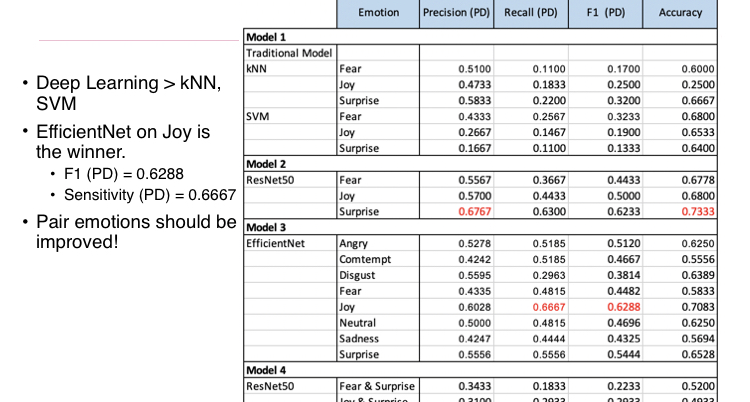Category: Technology
Objective: To apply deep learning and traditional machine learning approaches to images of different facial expressions from patients and controls to aid in the prediction of PD.
Background: Impaired facial expressions are a common symptom of Parkinson’s disease and may provide valuable clues for early diagnosis. The recent advancements in computation techniques and processing units together with the availability of larger datasets enable the possibility of using artificial intelligence (AI) techniques, especially a deep learning approach, for computer vision tasks in medical diagnosis.
Method: Four classification models were applied to evaluate the facial images; two traditional machine learning techniques: k-Nearest Neighbour (kNN) and Support Vector Machine (SVM) and two modern deep learning techniques: ResNet50 and EfficientNet. The images were collected using ChulaPD mobile application. Participants were asked to perform eight different facial expressions; neutral, joy, sadness, anger, fear, surprise, disgust, and contempt. The images were sent to the cloud-based storage for data analysis.
Results: The image augmentation techniques were applied to 1,016 images, 384 images from PD and 632 from HC, to artificially expand the size of the training dataset. Three-fold cross-validation was performed to address the overfitting or selection bias. Single and combined expressions were evaluated according to the aforementioned models. The ‘Joy’ expression with EfficientNet was the best to differentiate between PD and HC; Accuracy = 0.7083 and Sensitivity= 0.6667. ResNet50 had the best result with ‘Surprise’ expression; Accuracy = 0.7333 and Sensitivity= 0.6300. The best result from traditional models was from SVM with ‘Fear’ expression; Accuracy = 0.6800 and Sensitivity = 0.2567.In our experiments, deep learning techniques consistently outperformed traditional machine learning techniques.
Conclusion: Diminished facial expressions are one of the common indicators of PD, facial recognition using a deep learning technique could play a role in an improvement of the detection and diagnosis of an early-stage PD. This pilot study offers a simple, non-invasive, AI-assisted tool to differentiate the facial expressions of PD patients from healthy control, with the potential to be a promising future tool for screening a large number of high-risk PD population.
To cite this abstract in AMA style:
O. Phokaewvarangkul, P. Vateekul, D. Surangsrirat, R. Bhidayasiri. Deep learning approach for Parkinson’s disease classification from facial expressions: A pilot feasibility study [abstract]. Mov Disord. 2020; 35 (suppl 1). https://www.mdsabstracts.org/abstract/deep-learning-approach-for-parkinsons-disease-classification-from-facial-expressions-a-pilot-feasibility-study/. Accessed July 10, 2025.« Back to MDS Virtual Congress 2020
MDS Abstracts - https://www.mdsabstracts.org/abstract/deep-learning-approach-for-parkinsons-disease-classification-from-facial-expressions-a-pilot-feasibility-study/

